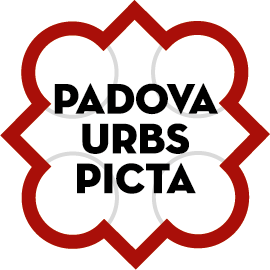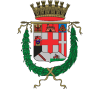Starting-point: Via Euganea, at the Ponte di San Giovanni delle Navi.
This spot too was one of the city’s river ports; you can see the remains of it incorporated into the houses that back onto the Canale Maggiore del Bacchiglione, which runs alongside the city walls. If you want to, you can programme an entire itinerary that takes in the historical city gateways and bridges of Padua.
If you continue along Riviera Paleocapa, alongside the canal, you pass through the area that was once the location of the Dominican monastery of St. Augustine. The Basilica dedicated to the saint housed the mortal remains of the Carraresi family and of the philosopher/physician Pietro d’Abano; with the exception of a single cloister, the entire monastery complex was destroyed at the beginning of the nineteenth century. This stretch of the canal was also called the Saracinesca, given the presence of a massive sluice-gate (saracinesca) that was closed each evening to prevent smugglers using the waterway.
From Ponte Sant’Agostino you can already see the so-called Torlonga [Tall Tower], that is now home to the Specola Observatory (position on map: 39); you can also see the rear of the Carraresi Castle, which was long used as a prison. This building is now home to the ‘La Specola’ Museum, which is an astronomical museum that is well worth a visit.
Turning onto the wrought-iron Ponte Paleocapa, which overlooks the Specola Nature Oasis, continue to the other side and then turn left into Via Tiso da Camposampiero. Having crossed through the underpass, you see on your right the small but beautiful Oratory of St. Michael (map: 38). Retracing your steps, you can now visit the Museo della Specola and then go back to Riviera Paleocapa, turning right off Ponte Sant’agostino onto Via San Tommaso Becket (map: 40). At number 3 in this street is the church that gives it its name; the picture gallery linked with it has a rich collection of local works from the Baroque period.
The Vescovado Area
Retracing your steps slightly towards the bridge, turn right into Rivera Albertino Mussato, continuing along it to the junction with Via Vescovado. Turning right you can walk along one of the finest and most historic streets in Padua. A palazzo that stands out here is the so-called Casa degli Specchi; built by Cesare Maggi in the first years of the sixteenth century, this takes its name from the numerous square and round blank panels (specchi) of polychrome marble that adorn the Lombard-style facade. At the end of the street, you turn left into Piazza del Duomo (map: 19), where you can see the fine Cathedral [duomo] and the Baptistery; this latter is a circular-plan building whose interior is covered with frescoes by Giusto de’ Menabuoi which are considered one of the masterpieces of Paduan art. In the piazza stands the Palazzo Vescovile, now home to the Diocesan Museum, and on the far side of the piazza is the old Monte di Pietà, a medieval pawn bank.
The Old Ghetto
Opposite the Diocesan Museum, turn into Via Soncin, which leads you into the Old Ghetto that used to be the centre of Jewish life in the city. This community was particularly large in Padua, which welcomed other cultures as a way of stimulating not only the achievements of the university but also the city’s commercial life; Padua was noteworthy for its ability to combine both secular independence and a powerful sense of the spiritual (as can be seen from the number and size of religious foundations here). These streets are particularly attractive because they have maintained their original character and are now full of shops and workshops that bring together artistic and artisanal creativity. For the people of Padua itself, this area is associated with the daily ritual of lo spritz, the apertitivo for which it is customary to gather in the area known simply as le piazze. Combining the Ghetto, the Listòn, Piazza del Duomo and Piazza della Erbe, Piazza della Frutta and Piazza dei Signori, this whole area is also a fine place to sit out in the sun, to enjoy a leisurely Sunday breakfast or to treat yourself to a evening in one of the many osterie that serve local delicacies and fine wines from the Euganean hills. From Via Soncin, you turn left into Via delle Piazze, where at number 28 you find the old synagogue.
The Carraresi Palace
When you enter Via San Canziano (map: 49), you find the church that give it its name on the corner. Turning left to the side of Piazza delle Erbe (map: 16), you can walk past the Palazzo della Ragione (map: 15) and then pass into Via Daniele Manin, at the end of which (again on the right) you enter Via Monte di Pietà. From here you pass through the archway under the Clock Tower in Piazza dei Signori (map: 18) to enter the site of what was the Carraresi Palace (map : 20). You walk through it by crossing Piazza Capitaniato then turning left into Via Accademia and then left again, down Via Arco Vallaresso, towards Piazza Duomo.












